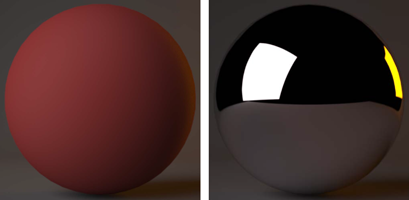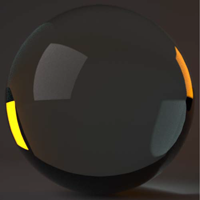...
A surface which scatters almost all light in a chaotic, diffuse way is called a "lambertian" surface, such as the red ball on the left. Lambertian reflectance means that light falling on a surface is scattered in such a way that the apparent brightness of the surface is the same, regardless of the observer's angle of view. Or else: the surface's luminance is the same regardless of angle of view. Many rough surfaces, such as unfinished wood, exhibit lambertian reflectance.
| Section | |||||||||
|---|---|---|---|---|---|---|---|---|---|
|
A smooth surface however reflects light uniformly and creates a very sharp or specular reflection of its environment. Specular reflection is the perfect, mirror-like reflection of light from a surface, in which light from a single incoming direction is reflected into a single outgoing reflection, as for example with a mirror.
...
An object becomes transparent when light does not stop at the surface, but goes through the object and out the other side. When light passes through a material, it slows down because the material is denser than vacuum. Because of this change in speed, the light is bent, or refracted, when going from vacuum (or air) into the material. This refraction occurs whenever light changes speed, so it happens when it moves from one material to another with different densities. The refraction is also what causes "caustics": concentrated pools of light.
In the example below, it is refraction that makes the magnifying glass distortion, and creates the caustics pattern. Different materials make light slow down more or less, relative to the speed of light in air or vacuum. This difference between lightspeed in vacuum <--> lightspeed in medium, is specified as the index of refraction (IOR, also called Nd) for that particular medium.
| Column | ||
|---|---|---|
|
The Fresnel Effect
The Fresnel effect is the apparent increase/decrease of a surfaces reflectance based on viewing angle. For example, if you look at your monitor screen straight on, the monitor glass shows almost no reflection, but if you look at it from an angle almost parallel to the glass, it has become very reflective. The Fresnel effect is dependent on the Nd of the material. The higher the Nd, the more reflective the material becomes at ALL angles, so the Fresnel effect diminishes: the material becomes equally reflective at all angles.
...

